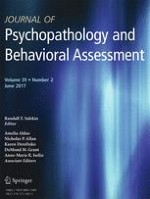27-01-2017
Factor Structure of the Difficulties in Emotion Regulation Scale (DERS) in Adult Outpatients Receiving Dialectical Behavior Therapy (DBT)
Gepubliceerd in: Journal of Psychopathology and Behavioral Assessment | Uitgave 2/2017
Log in om toegang te krijgenAbstract
The Difficulties in Emotion Regulation Scale (DERS; Gratz & Roemer in Journal of Psychopathology and Behavioral Assessment, 26, 41–54, 2004) is a widely used measure of emotion regulation, however, few studies have examined the scale’s psychometric properties in clinical samples. The current study examined the latent factor structure of the scale, in addition to other psychometric properties, in a naturalistic sample of adult outpatients (n = 344) receiving dialectical behavior therapy (DBT). A number of models were fitted, including a bifactor model, which has not previously been examined with the DERS, but which may be more appropriate for addressing the study’s two primary aims. These aims were to: (1) investigate some of the prior concerns raised about the Awareness subscale items; and (2) evaluate the appropriateness of using DERS total vs. subscale scores. Results indicated that a modified bifactor model which excluded the Awareness items from the general factor fit the data best. Additional findings suggested that the DERS total score (excluding Awareness items) was reliable and had good criterion-related validity in this sample. However, the findings related to the DERS subscales were mixed. This study extends prior research on the DERS by demonstrating the utility of the scale with individuals receiving DBT for problems with emotion regulation, as well as by clarifying some of the prior questions about the scale’s latent structure.
